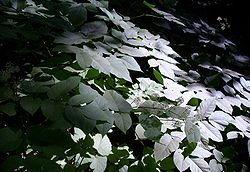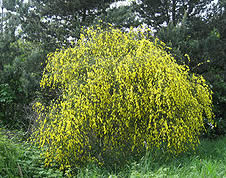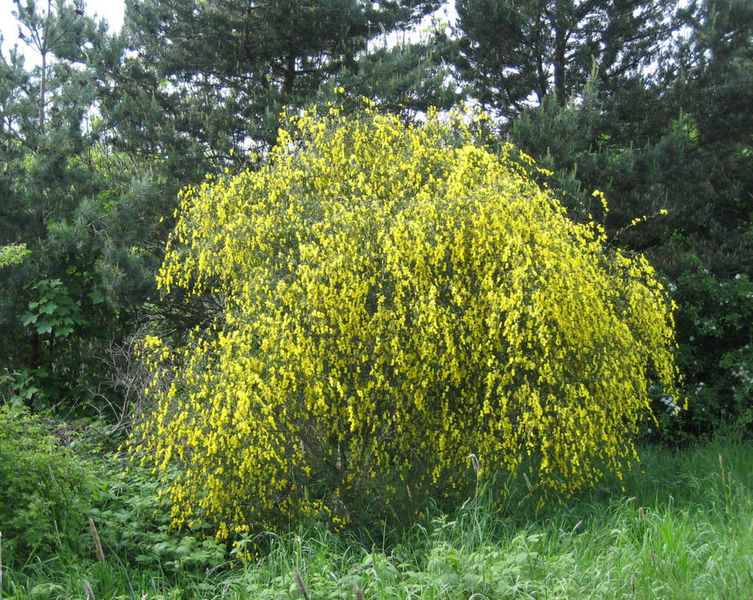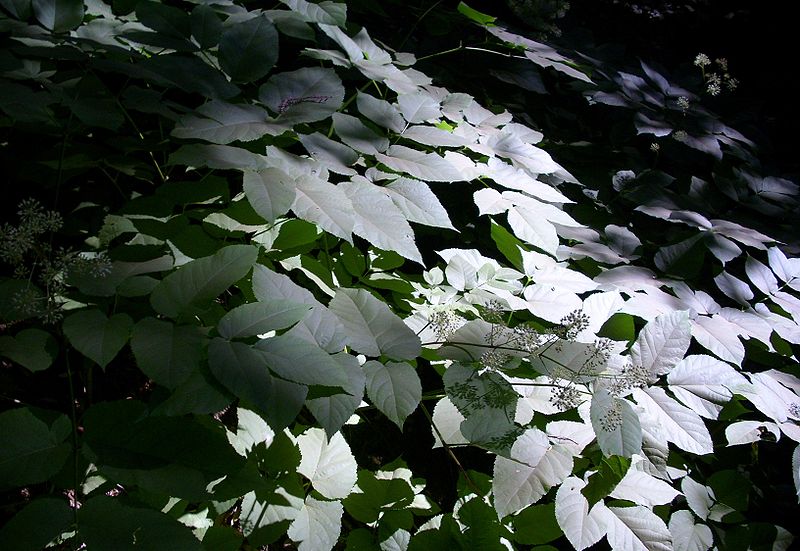Bush or Shrub
A shrub or bush is a horticultural rather than strictly botanical category of woody plant, distinguished from a tree by its multiple stems and lower height, usually less than 5-6 m (15-20 ft) tall. A large number of plants can be either shrubs or trees, depending on the growing conditions they experience. Small, low shrubs such as lavender, periwinkle and thyme are often termed subshrubs.An area of cultivated shrubs in a park or garden is known as a shrubbery. When clipped as topiary, shrubs generally have dense foliage and many small leafy branches growing close together. Many shrubs respond well to renewal pruning, in which hard cutting back to a 'stool' results in long new stems known as "canes". Other shrubs respond better to selective pruning to reveal their structure and character.
Shrubs in common garden practice are generally broad-leaved plants, though some smaller conifers such as Mountain Pine and Common Juniper are also shrubby in structure. Shrubs can be either deciduous or evergreen.
Planting Shrubs
Drainage
Backfill
Backfill or planting soil should be of equal or better quality than the soil in which the plant originally grew. General recommendations call for a mixture of equal parts of organic matter, coarse sand and top soil. All backfill should be easily workable and free of debris.Setting the Plant
Many plants fail to live because they are set too deeply in the planting pit. When this occurs, the plants suffocate as sufficient air does not reach the root system. Balled and burlapped or container grown plants should be so planted that the earth ball rests 1 to 2 inches above soil level (See Figure 2). This allows for settling to the proper depth. Apply mulch around the plant to protect the roots. Bare root trees and shrubs should be planted at the depth which they originally grew (See Figure 1). A ‘collar’ is generally evident at the base of the stem or trunk indicating this depth. Keep the plant in an upright position at all times unless a special leaning effect is desired.- Loosen the soil generally to eliminate compaction and improve drainage
- Improve background fertility by incorporating fertiliser, organic matter and lime
- Ideally, assess the need for lime with a soil pH test
- Improving the soil for a wide area (2-3m (6½-10ft) around the tree) is best practice
- If soils are waterlogged over winter consider installing drainage, or an alternative is to plant on a slight mound, about 25-30cm (10in-1ft) high and 1m (39in) in diameter. Excess moisture can kill the finer roots, which become blackened and sour smelling. Wet roots are more susceptible to disease, especially Phytophthora root rot
Guide to planting
- Remove plants from containers or fabric wrapping (some specimen trees specify that the wrapping be left on under the terms of their guarantee, but normally fabric wrappings should be taken off)
- Tease out and spread the roots to get an idea of their spread. Dig a planting hole that is no deeper than the roots, but is up to three times the diameter of the root system
- If the sides or base of the planting hole are compacted, break the soil up with a fork before planting
- With container grown plants, the top layers of compost should be scraped away, and the point where the roots flare out should be near the soil surface
- Place the plant in the planting hole
- Refill the planting hole carefully, placing soil between and around all the roots to eliminate air pockets
- There is little evidence that adding extra fertiliser and organic matter to the planting hole helps; in fact this practice can hinder plant establishment as the organic matter decomposes and may cause the plant to sink. There is also less incentive for the roots to grow out into the surrounding soil
- Firm the soil gently, avoiding compacting the soil into a hard mass
Watering
The remaining step is to make provisions for watering the plants. This may be accomplished by constructing an earth ring around the plant, leaving a depression in the earth around the plant, or inserting drain tile filled with gravel around the plant . During winter months earth rings should be removed or the depression filled. This is done to prevent water from collecting around the plant, freezing and damaging the trunk. Watering is an operation in plant maintenance that is too often hurriedly executed. Newly planted trees and shrubs require more water than older, established plants. Generally, newly planted trees and shrubs should be watered thoroughly once a week. Heavy watering once a week is preferred over daily evening sprinklings which force the roots to the surface to obtain moisture. Shallow rooted plants are more susceptible to drought than deeply rooted ones. Sandy soils may require more frequent watering while heavier soils may require less.Weeding
Weeds, lawns and other vegetation intercept water before it reaches the roots of newly planted trees and shrubs.- Keep a vegetation-free circle at least 1.2m (4ft) in diameter around the plant for its first three years to help avoid this problem
- The circle can be kept weed free through hoeing or use of contact or systemic weedkillers
- Laying mulch over this circle is also helpful, although take care to leave a collar of 10cm (4in) around the woody stems that is free of mulch, to prevent the risk of rotting the bark
Problems
Planting too deep is a common cause of tree death. Aim to plant at the same depth that the tree was growing in the nursery. Poor establishment and brown leaves are also sometimes encountered after planting.Guide For All Shrubs and Bush Plantings
- Two people should be available when trees and shrubs are to be planted.
- Handle trees and shrubs carefully. Balled and burlapped plants should be carried by the earth ball, not by the trunk.
- Keep bare roots covered at all times with wet burlap and keep earth balls moist at all times.
- Trees and shrubs should be held in an upright position at all times after placing in the planting pit.
- Plant only healthy trees and shrubs.
- Remove all broken or damaged branches and roots.
- Have all necessary equipment and materials handy at the time of planting.
- Plant trees and shrubs as soon as they arrive.
- Water trees and shrubs well after planting and keep the soil moist at all times.
- Mulch after planting.
- Remove all tags and labels that may cut or rub the bark of the plants.
- Guy or stake trees in position to prevent roots from becoming loose in the soil.
- Eliminate all air pockets in the planting pit.
- Make certain the soil drains properly.
- Protect plants against damage by lawn mowers, automobiles, etc.
- Check plants periodically for loose wrappings and wires, broken limbs, insect or disease damage, drainage and proper moisture.
- Planting should not be done when the soil is wet or soggy. The soil should be loose and workable.








